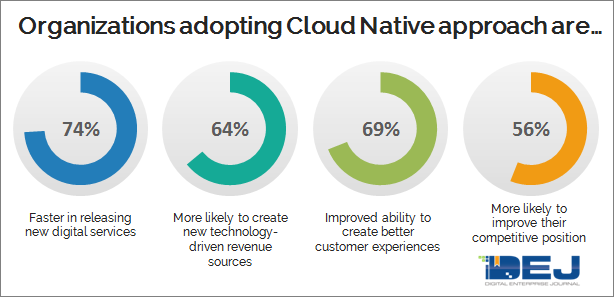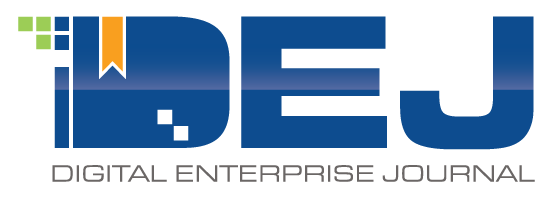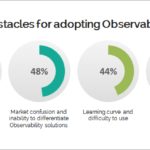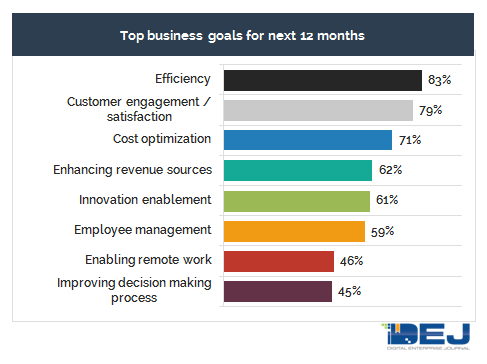This Research Note is an overview of key briefings that DEJ conducted with technology vendors in March of 2022 based on their alignment with findings of DEJ’s research. The note analyzes vendors’ market position and their ability to meet key user requirements.
DEJ’s study on the state of IT performance shows a 28% increase in the importance of managing the performance of digital services from the end user’s perspective over the last 12 months. This is exactly what 1E does by offering solutions for managing digital employee experience (DEX). The core of the company’s technology offerings is a Tachyon platform that includes a broad set of capabilities that are well aligned with a number of key user requirements from DEJ’s research.
- Data management and creating actionable insights. DEJ’s upcoming study on Strategies of Leading Organizations in Adopting Observability shows that leading organization (top 20% of the survey participants based on performance) are 80% more likely to report that having more data helps with improving visibility into their environments and creating actionable insights. On the other hand, 56% of all other organizations reported increasing amounts of data as one of the key challenges. 1E provides capabilities that are well aligned with the approaches of leading organizations and some of them include the ability to process and analyze real-time data, the ability to go beyond insights and get to answers and actions and the ability to process large amount of data.
- Impact of change. DEJ’s research shows that 76% of all performance problems can eventually be traced back to changes in the environment. However, the research also shows that 67% of organizations don’t have the ability to identify change(s) in their environments that caused performance issues. 1Es Tachyon enables organizations to go back in time and identify those changes which helps reduce MTTR.
- Automation. Automation is really in the core of 1Es value proposition. DEJ’s upcoming study on Modernizing IT Operation shows that automation-enabled capabilities play a key part in transforming the role of IT Operations from troubleshooting and “keeping the lights on” to an innovation enabler. One of the key differentiators of 1Es offerings is the company’s approach for dealing with performance issues where, after it enables identifying and resolving the problem, automates the troubleshooting process so organizations do not have to deal with the same issue again.
- Digital Transformation enablement. 57% of organizations in DEJ’s recent study on The Total Business Impact of IT Performance reported lack of visibility into usage of transformational technologies as a key challenge for employee management. 1E allows organizations to create groups of users based on technologies they are using and quickly determines what is being used and what is not being used, while also providing insight into user sentiment.
The combination of these capabilities, coupled with self-healing and proactive problem prevention competencies enables organizations to drive autonomous operations, which makes 1E well positioned to impact some of the key business outcomes.
Aiven is a software company, but its offerings are delivered as a managed service. The company’s data infrastructure management platform is deployed on top of different types of open source technologies. DEJ’s upcoming study on Observability shows that top performing organizations (TPOs – top 20% of research participants based on performance) are 74% more likely to be relying on open source. As a result, they are able to generate 4.6 times more revenue from new digital services, as compared to all others.
Open source is the core of Aiven’s offerings, but the company’s automated, self-service platform allows organizations to automate Aiven’s managed service as much as possible.
DEJ’s research also shows a 3.9 times increase in adopting a cloud native approach over the last 3 years. Aiven’s platform is fully cloud native which allows the company to meet some of the key user requirements. DEJ’s research shows time-to-value and the ability to future-proof their technology environments as the top selection criteria for new purchases. These are some of the key strengths of Aiven’s offering, along with low TCO and strong reliability and security capabilities.
Some of the other important attributes of Aiven’s offerings are flexibility, predictability and a security-first approach. The company allows organizations to run their service on a cloud of their choice and avoid lock-in while offering 3 deployment options. Also, Aiven has a very transparent pricing model with no hidden costs.
In October of 2021, Aiven received a $2 billion evaluation and extended its Series C round of funding to $160 million. That doesn’t come as a surprise, as the company’s approach is very well aligned with key user requirements.
Asserts is a start-up that is providing Observability solutions by adding an intelligence layer on top of a Prometheus monitoring stack. Fifty-nine percent of top performing organizations in DEJ’s upcoming study reported that they are using open source technologies as elementary pieces for building their Observability solutions. However, the research also shows that these organizations are less likely to rely solely on open source solutions, as they need additional capabilities to create actionable insights to quickly solve performance and quality issues.
Asserts utilizes Prometheus metadata to create actionable context. Metric data is continuously analyzed for anomalies and failures. The solution then provides application mapping and contextual dashboards, alerts enrichment, automated health checks and problem detection. DEJ’s study found that using capabilities like Asserts enabled leading organizations to experience an average MTTR per incident that is 4 times shorter than that for all others (43 vs. 172 minutes). The solution easily deploys adjacent to your existing Prometheus stack and needs no agents to be installed.
Asserts came out of stealth mode in February and is backed by Andreessen Horowitz. The company’s ability to create actionable insights from your existing Prometheus’s ecosystem coupled with strong automated capabilities for guiding organizations from problem detection to identifying the root cause and ease of integration with your Log and Tracing solutions, makes a very good foundation for Asserts’ future growth.
CAST AI provides a solution built for Kubernetes that enables organizations to continuously optimize cloud cost while maintaining the same levels of performance. DEJ’s upcoming study on Managing Kubernetes shows that finding the right balance between cost and application performance is a key challenge for 66% of organizations. CAST AI’s solution makes the optimization process completely autonomous and analyzes the configuration and the predictive needs of the Kubernetes application in real time and rightsizes it to the right amount of computing resources. Additionally, the solution selects the most cost-efficient computing resource every time there is a scale up event, which results in monetary savings being even higher than reduction in resource usage.
DEJ’s research shows that 73% of organizations are not aware that they are overpaying for cloud services when managing Kubernetes. The research also shows that the average difference between resources that organizations are paying for and what they really need is 46%. The first step in getting value from CAST AI’s solution is a detailed analysis of resource utilization which is followed by completely automated processes for optimization and, ensuring that the environment stays optimized. In addition to cost optimization, CAST AI’s solution is well aligned with other key user requirements discovered in DEJ’ Kubernetes Management study.
- 61% of organizations reported that the increasing complexity of management is one of the challenges. CAST AI’s autonomous infrastructure helps address this issue. Additionally, the company enables organizations to consolidate multi cluster management on one screen which further simplifies Kubernetes operations.
- DEJ’ research found that leading organizations are 77% more likely to have capabilities for automated real-time rightsizing. As a result, their developers and engineers are spending 2.6 times less time on unplanned work. This capability is a major part of CAST AI’s offerings.
DEJ’s recent study on the business impact of IT performance shows that organization are losing, on average, $21.58 million annually due to not acting when it comes to cloud management. CAST AI provides strong capabilities for addressing this issue by providing a solution based on strong analytics and intelligent automation functionalities that go well beyond recommendations and enable a true autonomous continuous optimization.
DEJ’s upcoming study on Observability shows that 58% of organizations are losing visibility due to the high cost of data storage and processing. This challenge goes beyond Observability and it is becoming prevalent across different industries and use cases. Organizations are increasingly losing insight due to complexity, cost and time and resources needed to analyze data.
ChaosSearch provides a unique solution for this problem by eliminating the need for creating data pipelines and moving the data. The company’s data lake platform indexes cloud data, makes it fully searchable and enables both search and SQL-based analytics. All of this is conducted in an automated fashion and on a massive scale. ChaosSearch enables organizations to simply stream the data into their cloud object storage. Customers can then use ChaosSearch to virtually clean, prep, and transform their data, while leveraging Kibana distro or open APIs to let data consumers use the analytics solution of their choice, essentially eliminating everything between the data lake and the user.
DEJ’s recent study revealed that 68% of an IT team’s time is spent on tasks that do not contribute to key business outcomes. Additionally, the research shows that lack of resources (64% of organizations) and actionable insights (62%) and increasing complexity (57%) are the key obstacles for digital transformation and using technology as a business advantage. ChaosSearch’s platform allows organizations to address each of these challenges and enables them to focus on creating business value instead of using resources for maintaining their existing environments. By eliminating time spent on creating data pipelines, the company allows organizations to free up resources for innovation and higher-value work while also reducing complexity.
Additionally, by allowing organizations to avoid cost-insight trade off, ChaosSearch serves as a key enabler for organizations to use data and actionable insights as a competitive differentiator.
On February 7th, Chronosphere, a provider of Observability solutions, announced a $200 million round of funding with the company being valued over $1 billion. Additionally, on February 17th, the company also announced a 16x growth in annual revenue. There are several factors that contributed to the company’s success.
– Increasing demand for solutions that are designed for managing dynamic complex environments. 47% of organizations in DEJ’s recent study on the state of IT performance reported that the effectiveness of their IT performance monitoring solutions declined over the last 2 years. Organizations are increasingly realizing that they were built for addressing problems from 5-10 years ago and do not have capabilities for managing modern environments for monitoring applications and infrastructures that are based on microservices and containers. Chronosphere’s solution is built for these types of modern environments and includes strong capabilities for dealing with large amounts of monitoring data and correlating data from different domains.
– Addressing key obstacles for adopting Observability. DEJ’s upcoming study on Strategies of Leading Organizations in Adopting Observability identified key challenges in deploying Observability solutions (Figure below). Addressing these issues are some of the key strengths and differentiators of Chronosphere’s solutions. The company allows customers to determine what data is kept, for how long and at what level of granularity which helps organizations to gain control over data and optimize cost. Additionally, Chronosphere allows organizations to leverage their existing open source tools, which reduces a learning curve for adopting Observability.
Figure 1
– Providing capabilities with the strongest impact on performance. DEJ’s research identified a number of capabilities that top performing organizations (TPOs) are more likely to be deploying and are having the strongest impact on performance. Some of these capabilities are provided, or enabled by Chronosphere.
- TPOs are 71% more likely to have capabilities for correlating Observability and business data, as compared to all others.
- TPOs are 2.3 times more likely to be centralizing management of their Observability initiatives. Chronosphere enables this initiative by monitoring usage per team, per service and per application.
- TPOs are 64% more likely to have the ability to measure the impact of performance issues, as compared to all others.
- TPOs are 57% more likely to use the reliability of Observability solutions as a key selection criteria. Reliability is one of the core strengths of Chronosphere’s offerings.
DEJ’s research findings not only clarifies drivers behind Chronosphere’s current success, but also shows that the company is well positioned for future growth, especially as more organizations are looking to provide business context around their Observability deployments and centralize their Observability initiatives.
Coralogix is a data platform powered by in-stream analytics that is addressing the #1 challenge of adopting Observability – finding the right balance between cost and performance – in a scalable fashion. The company is known for log analytics, but its platform can analyze any type of data, including metrics, tracing, and security events, without indexing it. DEJ’s upcoming study on Strategies on Leading Organizations in Adopting Observability reveals that top performing organizations (TPOs – top 20% of the research participants based on performance) are 3.3 times more likely to have defined strategies for Observability data management, which allows them to go beyond insights and intelligence to getting answers.
DEJ’s study shows that TPOs are 61% more likely to be deploying capabilities for real-time analysis of streaming data. As a result, these organizations are experiencing 85% better visibility in their environments, while reporting 2.4 times lower cost of Observability as compared to all others. Coralogix’ Streama© technology for real-time in-stream analysis also includes strong capabilities for data enrichment, dynamic contextual alerting and anomaly detection. Coralogix also provides strong capabilities for proactively preventing performance issues and DEJ’s recent study show that organizations are losing, on average, $36.34 million annually due to not having this competency.
Coralogix’ platform enables organizations to achieve a number of key business outcomes. Many customers are deploying it to optimize the cost of Observability, but the company’s strong analytics capabilities are also having a major impact on enabling innovation, improving customer satisfaction and engagement, generating new revenue sources and improving security.
Figure 2
DEJ’s recent study on the state of IT performance shows that organizations that are providing actionable context around data are 2.1x more likely to report that the data is their key asset, while others are 2 times more likely to report data management as one of the top challenges. Coralogix’ unique technology eliminates key obstacles for using data and insights as a competitive advantage.
DEJ’s recent study on the state of IT performance shows that the difference between the amount of data that top performing organizations (TPOs – top 20% of research participants based on performance) and all others are collecting is marginal. However, TPOs are 2.7 times more likely to report that data plays a key role in achieving key business outcomes. The main difference between the strategies of these two groups of organizations is that TPOs are twice as likely to de deploying capabilities for providing context around the data. Cribl’s Observability pipeline provides context around data management by enabling organizations to gain control over the amount and types data that is being sent to different destinations.
The company’s Cribl Stream solution collects and processes data from sources and streams it to destinations where it has the most value while optimizing its amount, enriching it and enabling organizations to route and replay it. DEJ’s upcoming study on Strategies of Leading Organizations in Adopting Observability identified key obstacles for benefiting from Observability solutions (Figure 1) .
Cribl is addressing all of the cost-performance trade-off by eliminating low value data from processing and storage and routing Observability data to a low-cost storage from where it can be replayed. The company also allows organizations to have full control over the data and avoid another key challenge of Observability, a vendor lock-in. Cribl also enables organizations to improve visibility and control over their dynamic environments by processing data before storing it and allowing them to create more actionable insights while paying less.
On March 22, the company announced Cribl Edge, an edge based data collection system designed to collect, route, filter, and explore observability data where it is generated. Cribl Edge automatically collects logs, metrics and application data and processes and forwards it with low resource overhead. Cribl’s unique technology is being used by both IT Operations and Security teams, but its value proposition for enabling innovation, reducing inefficiencies, optimizing cost and improving the value of data is well aligned with key goals of business executives.
On February 22, Decodable announced a $20 million Series A of funding and a general availability of its real-time data platform. The company’s solution makes real-time data engineering easier and faster by enabling organizations to create data pipelines in a few minutes and knowing SQL is the only expertise required to use it. Decodable’s solution enables organizations to create and share streams that act as a public API so they can be customized and used based on business needs. The solutions is a pure SaaS service and eliminates the need for managing complex infrastructure and allows organizations to focus on creating a business value.
Decodable’s platform addresses a number of areas and use cases and eliminates some of the key challenges for innovation and using technology as a competitive advantage. Forty-two percent of organizations in DEJ’s research on Managing Kubernetes listed access to data as a key challenge for building and managing microservices. Decodable routes event data to the right microservices with a millisecond latency.
DEJ’s research also shows that 65% of organizations which are using real-time applications consider them to be critical for achieving key business outcomes, but building these applications is becoming increasingly complex and requires a high level of expertise. Decodable’s platform removes the infrastructure needs and eliminates requirements for having expensive platform teams.
The research also shows a 26% increase in the number of organizations that are deploying data mesh over the last 18 months and these organizations are experiencing a number of benefits, such as improved data governance and accelerated data-driven business outcomes. Decodable enables these organizations to create a self-service data mesh between teams and allows them to make the data available to any users within the organization. DEJ’s research shows that deployments of AI/ML models are rapidly increasing and organization that are leveraging these models are 44% more likely to report revenue increases driven by technology, as compared to all others. Decodable’s platform provides data needed for managing ML applications throughout the entire ML lifecycle.
Decodable’s solution works in three very simple steps. Connecting to data sources and sink, building a pipeline and monitoring and managing it and is a unique enabler for organizations that are looking to leverage data and technology as a driver for business growth.
DEJ’s upcoming study on Maximizing the Value of Engineering Work reveals that engineering leaders are 44% more likely to report a lack of processes for managing engineering operations as the key area for improvement as compared to a lack of DevOps tools. The research also identifies the key challenges that organizations are facing for managing engineering work.
Jellyfish’s engineering management platform enables organizations to address these challenges by providing engineering leaders data-driven actionable insights to improve their decision making process in several key areas The company’s solution enables strategic alignment of engineering work and business goals by helping organizations allocate resources to engineering tasks that matter the most to the business. Also, Jellyfish allows organizations to measure and optimize engineering operations and ensure that they have the right processes in place. The company also helps organizations streamline the software delivery process by identifying bottlenecks and the root cause of delays. To ensure that organizations are truly optimizing performance Jellyfish also enables them to measure productivity and collaboration of their engineering teams.
DEJ’s research shows a 2.4x increase in the number of organizations that have software as a core part of their business strategies over the last two years. Additionally, leading organizations in DEJ’s recent research on Kubernetes Management reported a 37% increase in revenue generated from new digital services. However, 67% of organizations reported that engineers time spent on non business critical tasks as a key challenge for modernization and using technology to achieve key business goals. As a result, DEJ’s study on the Total Business Impact of IT Performance reveals a $3.36 million average annual revenue loss due to engineers not focusing on business critical tasks.
As software is becoming the key difference maker between growing and declining businesses, maximizing the value of engineering work is becoming a critical business capability. Jellyfish’s solutions enable businesses to address each of the 8 key business goals that organization reported in DEJ’s research (Figure 2).
vFunction provides a unique AI-powered solution for application modernization that takes monolithic applications, analyzes them and intelligently extracts microservices code. DEJ’s research shows that organizations that are taking a cloud native approach are experiencing numerous operational and business benefits. However, for organizations that are deploying a large number of monolithic applications, it is very challenging to benefit from all of the opportunities that cloud provides around innovation.

53% of organizations in DEJ’s research reported the amount of technical debt as one of the key challenges for using technology to achieve their business goals. The research also shows that 69% of organizations are not able to calculate the amount of technical debt. vFunction enables organizations to manage different stages of the modernization process. It starts with an assessment that not only allows organizations to calculate technical debt and prioritize applications for modernization, but also allows them to translate technical debt into monetary figures by using AI-enabled functionalities and calculate ROI. The company’s capability to provide business context around application modernization does not stop there, as vFunction also provides a dashboard that enables organizations to gain visibility into cost and resources that are allocated for innovation vs. those that go toward technical debt.
DEJ’s research shows that the #1 goal for managing modernization is to create exceptional digital experiences (68% of organizations) and vFunction’s platform addresses all the key challenges of organizations that are losing a competitive edge due to the inability to use technology to achieve this goal. Some of the key challenges that vFunction’s automated platform is addressing for these organizations include complexity and dealing with large amounts of interdependencies, cost, talent (lack of skill and/or time available) and risk.
DEJ’s upcoming study on Managing Kubernetes shows that the cost of not acting around deploying microservices is very high and a recent study on The Total Business Impact of IT Performance revealed that organizations are losing, on average, $7.18 million annually due to not effectively managing the performance of micro services. vFunction enables organizations to address both of these areas, by not only providing a solution for accelerating the transformation of monolithic applications to microservices, but also removing the risk of modernization by minimizing any service interruptions, providing visibility and roll back abilities and enabling organization to continuously modernize.
















